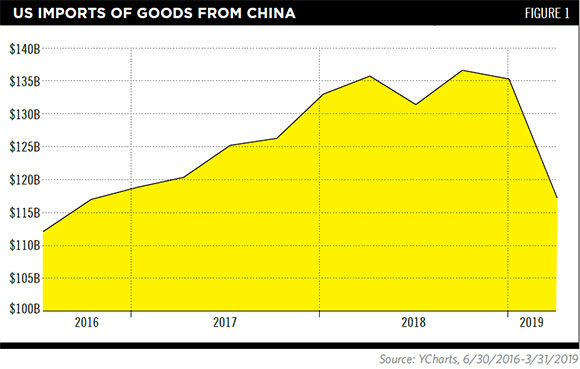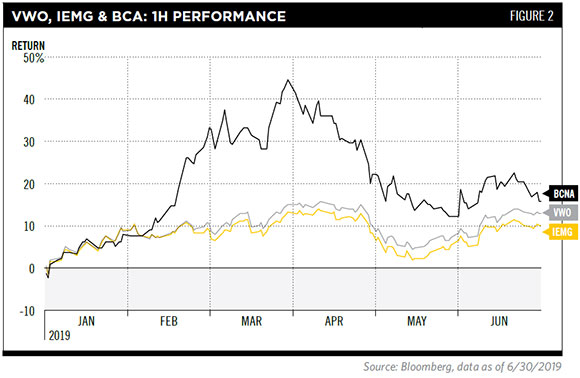
(ETF.com) The trade wars the U.S. started with developing markets such as China and Mexico are having ramifications across the globe.
Other emerging markets are feeling the impacts, not to mention how the blowback is affecting the U.S. and other developed markets. The U.S.’ decision to impose tariffs on a host of goods from China and Mexico led groups such as the International Monetary Fund and the World Bank to cut their forecast for global growth for the rest of 2019.
It’s also showing up in some industrial commodity markets. The United States Oil Fund LP (USO) ETF fell 10% from its 2019 high in April through June following crude oil’s price slide on worries of slackening energy demand because of the softer global economic outlooks.
With the U.S. and China both digging in their heels on trade negotiations, market watchers say it’s unlikely the situation will change soon. Further, many of them consider the Trump administration’s sudden move to link Mexican immigration with a new round of tariffs a game-changer. Not only did it introduce a nontrade factor into the mix, it put in jeopardy the recently negotiated U.S.-Mexico-Canada Agreement (USMCA), the trade deal to replace NAFTA.
“You remove the incentive for anyone in the world to come to the table to negotiate, because the rules of the game can change at any moment based on the whim of somebody,” said Brett Manning, senior market analyst at Briefing.com. “Then what’s the point in working hard to get a deal in place?”
Know What You Own
Due diligence to understand an ETF’s holdings is even more important now when considering broad-based emerging market ETFs, says Chris Cook, president of Beacon Capital Management.
Tom Essaye, founder of the Sevens Report Research, agrees: “The biggest takeaway for regular investors is you’ve got to look inside the ETF and see where they’re allocated.”
Compared to the SDPR S&P 500 ETF Trust (SPY), which was up 17% midyear, many emerging market ETFs are underperforming, but a closer look shows some surprises. The China-heavy Vanguard FTSE Emerging Markets ETF (VWO), which has a 50% weighting between China, Hong Kong and Taiwan, is up 9% midyear, while the iShares Core MSCI Emerging Markets ETF (IEMG), with a 42% weighting in those areas, is up 7.5%.
China’s relatively strong performance in the broad-based ETFs midyear was helped by cheap valuations, as last year was a suboptimal one for Chinese stocks, analysts have noted, and certain sectors like technology are doing well. One example is the Reality Shares Nasdaq NexGen Economy China ETF (BCNA), up 18% at midyear.
But that could change. Caleb Eplett, vice president of product management for YCharts, notes the U.S. dollar’s strength has softened the blow on U.S. consumers from the tariffs. However, he points to first quarter trade data showing we’re just starting to see a fall in Chinese imports (see Figure 1).
“We’re keeping a close eye on that, and we’re keeping a close eye on the currency,” Eplett said. “We’re also keeping a close eye on when consumers are actually going to pull back on their spending. When that starts to happen, it could turn into degradation of corporate profits.”
To Eplett’s point, while VWO, IEMG and BCNA show positive returns as of midyear, a deeper dive into charts shows all three ETFs came off their 2019 highs in the second quarter.
Holders of broad-based emerging markets have another reason to monitor their China exposure, as later this year, MSCI is expected to more than quadruple the Chinese mainland stock exposure in its MSCI Emerging Market Index, pushing it to 3.3% from 0.7%, a long-planned move.
Individual Markets Benefiting
Essaye says two emerging market ETFs are benefiting from the trade war concerns: The VanEck Vectors Vietnam ETF (VNM) and the iShares MSCI Thailand ETF (THD), which were outpacing broad-based emerging market ETFs as of midyear are up 10% and 13%, respectively.
With news reports pointing to some companies moving production out of China, Vietnam and Thailand are beneficiaries of that re-honed manufacturing supply chain. That might explain THD’s outperformance over VNM, as THD has a 15% weighting to industrials, while VNM has only a 3% weight there.

Essaye mentions South Korea could absorb any high tech engineering companies looking to relocate from China, but the iShares MSCI South Korea ETF (EWY) isn’t reflecting this possible shift in production, as it’s down 1% midyear.
He cautions advisors that these funds aren’t particularly liquid, and “if we see a global recession, all the emerging markets are going to get hit very hard. It doesn’t matter what’s happening to them individually.”
An indirect beneficiary from the U.S.-China trade war may be Russia, Essaye adds, as the fighting between the U.S. and China is causing the Asian nation to explore other economic alliances, with Russia being one. Russian ETFs, like the VanEck Vectors Russia ETF (RSX), are stronger this year, up 24% midyear, in part because crude oil prices were high until recently.
“China clearly has a vulnerability with us, given that they rely so much on us for their economy, and they’re looking to diversify away from that. Russia is a candidate for sure,” he said, adding that if oil prices continue to fall, Russian ETFs would likely drop too.
Complex Investment Issue
Mexico is a complex issue from an investment point. It should benefit from the U.S.-China trade war, Essaye notes, as part of the Trump administration’s beef with China is to ultimately return manufacturing production to the American continent. As of midyear, the main Mexico ETF, the iShares MSCI Mexico ETF (EWW), was up 8%; however, sources note there’s skittishness to invest in that country since the U.S. just brought immigration to the trade conflict with its southern neighbor.
Beacon’s Cook says companies thought the USMCA trade deal encouraged moving manufacturing to Mexico: “And then all of a sudden, we throw out the idea of tariffs for immigration purposes. These companies are having a very difficult time knowing where to go.”

Essaye suggests the ripple effect of Mexico’s immigration threat is likely limited to just that country, but it could pose a larger head wind to U.S. growth: “If I’m a small business, manufacturing something that comes out of Mexico, what’s my incentive to take on more risk for the next 18 months [until the next election]? Zero.”
Gold Takes New Shine
Another winner in the trade war skirmish is gold. The SDPR Gold Trust (GLD) hit five-year highs midyear on recent flight-to-safety moves. The slowing global growth, in part because of the U.S. tariffs, is opening another concern, Manning of Briefing.com notes, and global central banks are easing, including dovish talk from the Federal Reserve in June.
“We’re in uncharted territory, and it’s because of these monetary concerns, which is one reason I’m recommending buying gold,” he said.
Advisors’ focus now is on the trade war, but Manning says advisors need to consider alternative scenarios too. If Trump loses the 2020 election, and a moderate Democratic candidate like Joe Biden is elected, those tariffs are likely to be dropped. Or if there’s an unexpected deal with China, the stock market could rally further.
In that scenario, Manning said, “I would think that the transportation sector benefits. Something like an IYT [the iShares Transportation Average ETF] would fit the bill. It’s worth exploring what sorts of things could be most positively affected.”



